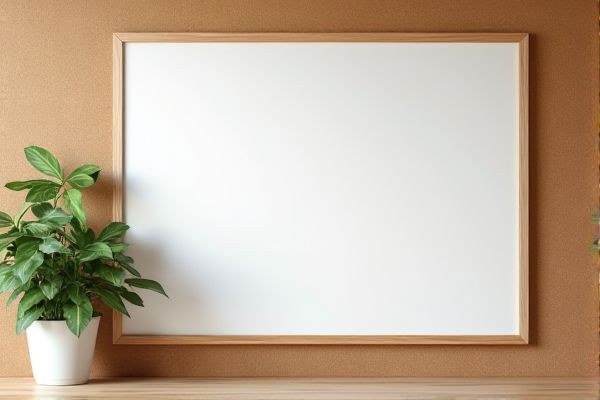
Corkboards provide a tactile surface for pinning notes and photos, enhancing visual organization, while whiteboards offer a smooth, erasable space ideal for dynamic writing and brainstorming sessions. Explore the rest of the article to discover which option best suits Your workspace needs.
Table of Comparison
| Feature | Corkboard | Whiteboard |
|---|---|---|
| Material | Natural cork | Melamine, glass, or porcelain surface |
| Primary Use | Pinning notes, photos, and documents | Writing and drawing with markers |
| Writing Surface | No | Yes, dry-erase markers |
| Reuse | Reusable with push pins | Reusable by erasing marker ink |
| Maintenance | Minimal, occasional dusting | Requires regular cleaning to avoid marker stains |
| Durability | Moderate, cork can wear with heavy use | High, especially glass or porcelain options |
| Cost | Generally affordable | Varies, from affordable to premium |
| Ideal For | Bulletin boards, displaying papers | Brainstorming, teaching, presentations |
Introduction to Corkboards and Whiteboards
Corkboards feature natural cork material that allows easy pinning of notes, photos, and reminders, offering a tactile and visual organization solution. Whiteboards provide a smooth, erasable surface ideal for writing, drawing, and brainstorming, often used with dry-erase markers for quick updates and collaborative work. Both tools serve as essential office or classroom aids, enhancing communication and productivity through distinct interactive methods.
Key Differences Between Corkboards and Whiteboards
Corkboards feature a natural, pin-friendly surface ideal for tacking notes, photos, and reminders, while whiteboards offer a smooth, erasable surface suited for writing and drawing with dry-erase markers. Corkboards provide a tactile, reusable space for physical items, promoting visual organization through pinned materials, whereas whiteboards emphasize dynamic, real-time communication and brainstorming with flexible, changeable content. The key differences lie in their material composition, interactivity, and primary use cases: corkboards specialize in static displays, whereas whiteboards facilitate active collaboration and frequent content updates.
Material and Durability Comparison
Corkboards are made from natural cork material, offering excellent pin-holding capability and durability resistant to wear from repeated pinning. Whiteboards consist of melamine, painted steel, or glass surfaces, providing smooth erasability and high resistance to staining and ghosting with proper maintenance. In terms of longevity, glass whiteboards outperform both cork and melamine due to their scratch resistance and ease of cleaning, while corkboards may degrade faster under heavy use or moisture exposure.
Ease of Use and Functionality
Corkboards offer straightforward pinning for quick note organization and visual reminders, making them intuitive for users who prefer tactile interaction. Whiteboards provide versatile writing and erasing capabilities, supporting dynamic brainstorming and collaborative work with markers and magnets. Your choice depends on whether you value easy physical attachment of items or flexible, reusable writing space.
Design and Aesthetic Appeal
Corkboards offer a warm, natural texture with earthy tones that complement rustic, traditional, and cozy interior designs, ideal for pinning notes, photos, and memorabilia. Whiteboards provide a sleek, modern appearance with a smooth, glossy surface that fits minimalist and contemporary spaces, facilitating dynamic writing and erasing for brainstorming and presentations. Choosing between the two depends on the desired aesthetic impact and functional needs within the workspace or home environment.
Organizational Benefits: Corkboard vs Whiteboard
Corkboards offer a tactile, visual method for pinning reminders, notes, and important documents, making them ideal for organizing paper-based tasks and fostering quick reference. Whiteboards provide a dynamic, erasable surface perfect for brainstorming, tracking schedules, and adapting plans in real time, enhancing collaborative workflow. Your choice between corkboard and whiteboard depends on whether you prioritize physical document management or flexible, interactive organization.
Maintenance and Cleaning Requirements
Corkboards require minimal maintenance, needing only occasional dusting and pin removal to keep them tidy, while whiteboards demand regular cleaning with a suitable eraser or cleaner to prevent staining and ghosting. Your choice depends on how frequently you want to clean, as whiteboards can accumulate marker residue that affects usability over time. Corkboards are durable and maintain their functionality with simple upkeep, whereas whiteboards need more consistent care to stay pristine.
Ideal Use Cases for Corkboards
Corkboards are ideal for organizing physical documents, photos, and memos in offices, classrooms, and home workspaces where tactile interaction is preferred. They excel in environments that require pinning and rearranging paper materials frequently, such as project planning, event scheduling, and brainstorming sessions. Corkboards provide a visual and tangible way to display information that supports team collaboration and quick updates.
Ideal Use Cases for Whiteboards
Whiteboards excel in dynamic environments like classrooms and offices where interactive brainstorming, quick note-taking, and frequent updates are essential. Their smooth, erasable surfaces facilitate real-time collaboration and visual communication, making them ideal for meetings, presentations, and planning sessions. You can easily organize ideas, track progress, and engage teams effectively with whiteboards.
Choosing the Best Option for Your Needs
Corkboards offer a tactile surface ideal for pinning notes, photos, and reminders, making them perfect for visual organization and creative displays. Whiteboards provide a smooth, erasable surface suited for dynamic planning, brainstorming, and frequent updates, enhancing collaboration and flexibility. Your decision should consider whether you need a permanent display with physical items or a versatile writing area for evolving information.
 homyna.com
homyna.com